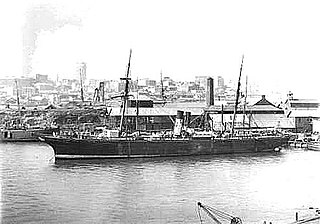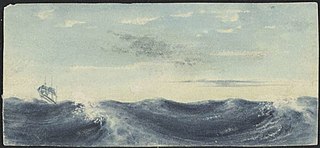Related Research Articles

John Williams was an English missionary, active in the South Pacific. Born at Tottenham, near London, England, he was trained as a foundry worker and mechanic.

Gorch Fock I is a German three-mast barque, the first of a series built as school ships for the German Reichsmarine in 1933.
Parmelia was a barque built in Quebec, Canada, in 1825. Originally registered on 31 May in Quebec, she sailed to Great Britain and assumed British registry. She made one voyage for the British East India Company (EIC), in 1827–1828. In 1829 she transported the first civilian officials and settlers of the Swan River Colony to Western Australia. She then made two voyages transporting convicts to New South Wales, Australia. A fire damaged her irreparably in May 1839.

Moshulu is a four-masted steel barque, built as Kurt by William Hamilton and Company at Port Glasgow in Scotland in 1904. The largest remaining original windjammer, she is currently a floating restaurant docked in Penn's Landing, Philadelphia, adjacent to the museum ships USS Olympia and USS Becuna.
Over 1400 ships have been wrecked on the coast of Western Australia. This relatively large number of shipwrecks is due to a number of factors, including:

The Georges Valentine Shipwreck Site is the site of the historic shipwreck of an Italian barkentine off the coast of Hutchinson Island in Martin County, Florida, with the nearest landmark being the House of Refuge at Gilbert's Bar.

Southern Cross is the name given to each of a succession of ships serving the Melanesian Mission of the Anglican Church and the Church of the Province of Melanesia. The first ship having this name succeeded the Undine, a 21-ton schooner built at Auckland and in service from 1849 to 1857.

The Gas Light and Coke Company, was a company that made and supplied coal gas and coke. The headquarters of the company were located on Horseferry Road in Westminster, London. It is identified as the original company from which British Gas plc is descended.

Gustaf Adolf Mauritz Erikson was a ship-owner from Mariehamn, in the Åland islands. He was famous for the fleet of windjammers he operated to the end of his life, mainly on the grain trade from Australia to Europe.

John Williams was a missionary ship under the command of Captain Robert Clark Morgan (1798–1864) and owned by the London Missionary Society (LMS). She was named after John Williams (1796–1839), a missionary who had been active in the South Pacific.

Lady Elizabeth is a wrecked iron barque of 1,155 tons built by Robert Thompson Jr. of Southwick, Sunderland and launched on 4 June 1879. Robert Thompson Jr. was one of the sons of Robert Thompson Sr. who owned and operated the family ran shipyard J. L. Thompson & Sons. Thompson Jr. eventually left the family business in 1854 to start his own shipbuilding business in Southwick, Sunderland. The ship was built for John Wilson as a replacement for the 658-ton, 1869-built barque Lady Elizabeth which sank off Rottnest Island, Western Australia in 1878.

City of Adelaide was an iron-hulled ship that was launched in Scotland in 1863, spent a long career in Australian passenger and cargo service, and sank off the coast of Queensland in 1916. She served with several Australian shipowners, including the Australasian Steam Navigation Company, Australasian United Steam Navigation Company and Howard Smith Company.

Captain John Dibbs was a master mariner prominent during 1822–1835 in the seas around the colony of New South Wales, New Zealand and the Society Islands. Dibbs was master of the colonial schooner Endeavour 1822–1824, the brig Haweis 1824–1827 and the barque Lady Blackwood 1827–1834. He is credited as the European discoverer of Rarotonga and several other islands. Most of his voyages involved the transporting of missionaries, trade, whaling and seal hunting. He was believed for over 170 years to have disappeared at sea in 1835. He was the father of Sir George Dibbs, a pre-Federation Australian politician, Sir Thomas Dibbs, an Australian banker, and John Campbell Dibbs, a successful Sydney businessman.

The New Zealand Company was a 19th-century English company that played a key role in the colonisation of New Zealand. The company was formed to carry out the principles of systematic colonisation devised by Edward Gibbon Wakefield, who envisaged the creation of a new-model English society in the southern hemisphere. Under Wakefield's model, the colony would attract capitalists who would then have a ready supply of labour—migrant labourers who could not initially afford to be property owners, but who would have the expectation of one day buying land with their savings.

Messenger of Peace was a missionary ship built in 1827 in Avarua, Rarotonga, by John Williams to spread Christianity to Samoa and the Society Islands on behalf of the London Missionary Society (LMS). He spread his ministry, sailing her from 1827 to 1836 under a flag of a white dove on a blue background while subsidising his efforts by trading between the islands.

Africaine, was a barque launched in 1831 at Jarrow on the River Tyne in England. In 1836 she carried immigrants as part of the First Fleet of South Australia. She was wrecked on 23 September 1843.
References
- 1 2 3 4 Wingfield, Chris (2015). "Ship's bell, United Kingdom". In Jacobs, Karen; Knowles, Chantal; Wingfield, Chris (eds.). Trophies, Relics and Curios?: Missionary Heritage from Africa and the Pacific. Leiden: Sidestone Press. pp. 127–129. ISBN 978-90-8890-271-0.
- 1 2 3 4 5 6 7 Powerhouse Museum. "H4686 Ship model, SS "John Williams IV", London Missionary Society steamer". Powerhouse Museum, Australia. Retrieved 2 July 2015.
- ↑ Hoskin, John E. (2018). "Burns Philip". Flotilla-Australia. Retrieved 3 April 2019.
- ↑ "Tyne Built Ships: A history of Tyne shipbuilders and the ships that they built". Tyne Built Ships. Retrieved 3 April 2019.